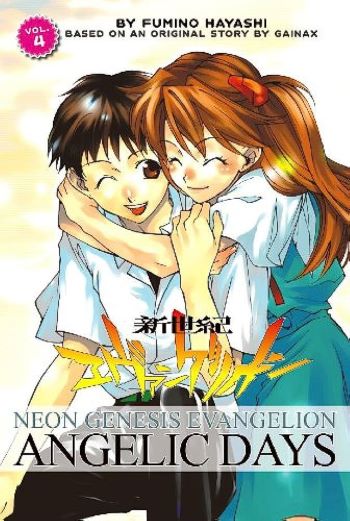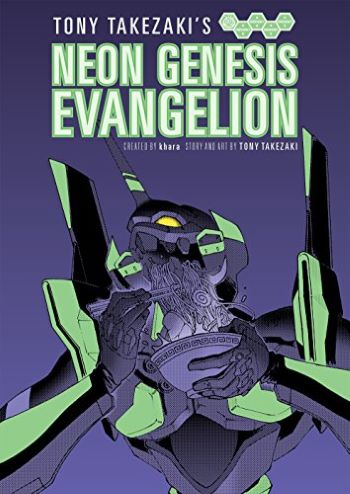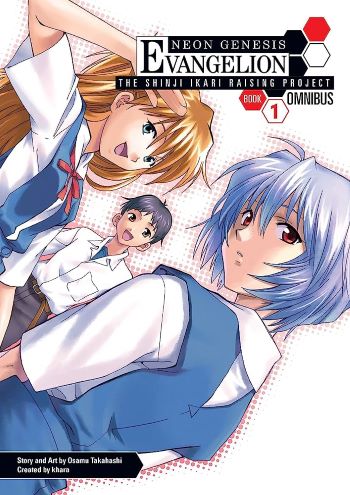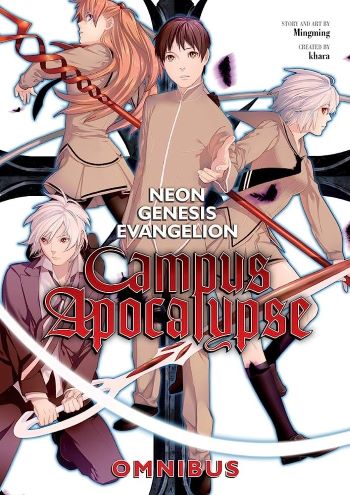Okay, so…
Originally, this article was supposed to cover the video game adaptations of NGE. It made sense as a next step, since SEGA helped bankroll the original anime’s production on the condition that it had first dibs on the game rights to the Evangelion IP, and the first video game (also the first spinoff) of the series, Neon Genesis Evangelion: First Impression, came out in the middle of the show’s broadcast.
There’s just one problem: the game isn’t available in English. In fact, most of the Eva games are not available in English. I was able to find the two Girlfriend of Steel games and the Shinji Ikari Raising Project in English, but even with that small sample size I discovered an issue, namely that video games are a much greater time investment than shows or books. Yes, I know, that should have been obvious to me, but I am, alas, not a gamer, and I quickly realized that even investing time in these three games would cause the gap between my third and fourth articles in this series to swell like the Ultimate Warrior, unless I half-assed it and shat out a review of games I barely touched.
More than that, I feel like an article examining the games deserves a larger sample pool than the one available to me now. If that means having to wait until translations of the other games come out, then, well, I guess that’s what I have to do. But in the meantime, if I can’t play the games, I can at least review the other main spinoffs of Evangelion.
Alongside the official NGE manga that I covered earlier, there’s a whole smorgasbord of other Eva manga out there, all with their own unique spins on the characters and world. So, what new insights can we glean from Shinji and his friends when they’re put into new contexts and plots? There’s only one way to find out.
Angelic Days

This is the very first manga spinoff of Evangelion, and while it’s ostensibly an adaptation of the Girlfriend of Steel 2nd game, it improves on that game’s plot in just about every way. While Girlfriend of Steel 2nd is ostensibly a further exploration of the baloney pony world we saw in Episode 26 of the show, it ends up trying to work with a premise where the Evas don’t exist and everyone is well-adjusted, while also trying to cram in as much fanservice and callbacks to the source material as possible, despite these things not making sense when divorced from their original foundations. For instance, it makes no sense for Asuka to be infatuated with Kaji when she barely knows him and is already deeply in love with Shinji. And it makes no sense for NERV to be building Evas when they weren’t supposed to fight Angels.
Angelic Days though decides “Okay, let’s say everyone is well-adjusted and doesn’t have the same trauma that they did in the show. How do we generate conflict then? Also, let’s bring back the Angels as the purpose of NERV, since that’s why everyone is reading, after all. You can’t have an Evangelion story without Evangelions, right?”
I’d actually be interested to see if the answer to that last question is “no”, but as for the first question, the answer Angelic Days settles on is “”Teen romance stuff.” We have a tendency to write off teen romance plots as silly or childish or fluff, but Angelic Days knows that a lot of the angst inherent to these stories comes from the pains of growing up. As Kaworu says, these angelic days in school where the friend group is in this configuration can’t last forever. Sooner or later, some of them will fall in love, some of them will move away, some of them will grow into a different person than the one they are now. Things can’t stay the same, no matter how much we want them to. But the conflict of the story is brought about by the characters trying to hold on to the way things were.
This is present to some extent in the original game, which is basically a dating sim, and the manga combines several of the routes into a single, cohesive plot. But while the game is, again, mostly focused on fanservice, the manga more thoroughly explores the consequences of the choices we make. Sometimes we have to choose between friends and obligations, and the opportunities presented by the routes we choose close off the opportunities from the paths not taken. It’s painful sometimes, but it’s also a necessary part of growing up.
This is why, while I was initially wary of Asuka in this manga, her being a little too tsun and not enough dere to be likable, once the manga establishes its central theme, you start to see what it’s doing with her. All the characters are faced with the question of holding on to the past or embracing the future, and Asuka is the one who clings most tightly to the past. Her more controlling and bitchy behavior towards Shinji comes from her fear of losing him and his friendship, as they grow up into different people than they were as young children. But this is something she has to learn to let go, because love ultimately requires you to recognize the object of your affection as their own, independent person. Shinji could leave her someday, and that’s terrifying, but unless she can accept that, and trust Shinji to remain by her side of his own volition, their relationship will turn toxic and ugly.
It’s a fascinating deconstruction of the whole childhood friend romance trope, and easily the manga’s greatest strength. However, while I enjoy what they did with Asuka in Angelic Days, what they did with Kaworu leaves me colder. Kaworu, like in the show, isn’t quite human, but he seems to be a wandering spirit, some higher being who wants to bestow happiness on mortals while not entirely understanding what that entails due to his own alien mental framework. In that regard, he plays a similar role to Rei from End of Evangelion, offering Shinji the comfort of fantasy and never growing up, which Shinji must reject in order to become a fully realized person. However, because the manga retains the homoerotic undertones of the KawoShin relationship, this causes the manga to associate same-sex attraction with immaturity and refusing to grow up, which might leave a bad taste in some readers’ mouths. I think Kaworu is a sympathetic enough character that he never becomes outright villainous or sinister (like he did in the NGE manga), but I figure I ought to at least give potential readers a heads-up on the unfortunate implications with him.
Perhaps the best way to describe Angelic Days is that it’s the Evangelion equivalent of Archie VS. Predator II. No I will not explain that metaphor further, but this does make me wonder if I’ll ever get to see the Eva kids destroy an Angel with the power of Jesus, or if the Evas or Angels will at some point start dancing and snapping their fingers like they’re in a gang. I guess we’ll just have to see.
Tony Takezaki’s Neon Genesis Evangelion

This is the second officially licensed Evangelion parody (the first being the After the End audio drama), and it feels pretty much like what would happen if Zucker, Abrahams, and Zucker made Evangelion. It has the same breakneck million-jokes-per-minute pace, the same fourth wall breaks, the same visual slapstick, and, sadly, the same tendency for its bawdy humor to sometimes cross the line into sexual harrassy humor that hasn’t aged well. Several of the jokes also feel like redos of the more metatextual gags of After the End, which while popular I’m sure, didn’t really land with me then or now. Even with these occasional gaffes though, the overall product is one I found myself blurt-laughing at multiple times, and which just manages to not overstay its welcome (even if some of the material is running a little thin by the end). It’s a fun, funny time, and a parody that shows a loving and detailed understanding of the material it’s riffing on. It is, essentially, the sort of parody you might find from Team Four Star or LittleKuriboh, and I’d highly recommend it.
The Shinji Ikari Raising Project

This is one of the two manga series I’d actually read before this retrospective, the other being Angelic Days. And while I’d read the first third of Raising Project back in High School, I ended up never finishing it. Partly this is because my local library only had the first third of the series, so I’d simply read all the books they had available. But more than that, as I was reading, I kept having a terrible, terrible thought in my mind, that thought being “This is gonna be like Ranma, isn’t it? It’s never gonna end, it’s just gonna sorta stop, and we’re never gonna get any real conclusion to things, are we?”
Having now read the whole series from start to finish, I can say that I was wrong and unfair in my initial assumption. The Shinji Ikari Raising Project does not turn out like Ranma. It turns out like The X-Files. It doesn’t really end, it just sort of stops, and you not only never get a real conclusion to things, but you realize at the end that the big, grand mytharc that they were teasing you with was all leading to a fat pile of nothing.
Wasted potential is kind of the whole MO of this manga. Like Angelic Days, it takes its inspiration from the baloney pony world of Episode 26, albeit with some slight changes. For instance, in this world, Rei comes to live with Shinji’s family, and Kaworu, whilst a shadowy SEELE operative, doesn’t seem to be anything more than a regular human. Also Mana shows up! From Girlfriend of Steel! That’s pretty neat. And she ends up having the same nerdy interests as Kensuke of all people. Gee, I wonder where this all will go.
Nowhere. The answer is nowhere. Raising Project will come up with these neat ideas, but then have absolutely no idea what to do with them, which results in most of them getting dropped almost as soon as they’re brought up. Plot devices activate so that the Shinji-Rei living situation is disrupted and we can get back to the Shinji-Asuka-Misato living situation we’re all familiar with. Kaworu and Mana have almost no relevance to the plot, despite them being so hyped up in their intros. And SEELE’s plan remains just as nebulous as it is nefarious.
The story of Raising Project is, ultimately, that of just another harem anime, which means that a good 90% of it is the same tired routine of nebbishy everyman Shinji having ambiguous relations with multiple women simultaneously, with loads of panty shots and boob collisions to keep things spicy. The manga is at least a little more self-aware than most harem anime with its ecchi contrivances (there’s an amusing running gag where Gendo is just as accident-prone as Shinji, making it seem like this harem protagonist aspect of Shinji’s character is hereditary), but by the end even that cleverness starts to run thin. Also, look, I love tits. I love anime. I love a good anime tiddie as much as the next guy. But these protagonists are in Middle School! Like, I don’t want any anime tiddies if they’re attached to a god-damn MS student! Get that shit away from me!
The one actually interesting insight I gleaned from Raising Project is an answer to the simple question: Why is AsuShin more common in Eva spinoffs than ReiShin? I’ll admit, back when I was a teen and only really had the og show and the first two Rebuilds to watch, I thought that AsuShin and ReiShin shippers were pretty evenly matched, both in terms of numbers and in terms of material. I knew there were more overtly romantic Eva spinoffs out there, but I sort of assumed there’d be just as many of those spinoffs where Shinji ends up with Rei as there are where he ends up with Asuka. Thus far though, all the spinoffs I’ve encountered either don’t answer the question or have Shinji end up firmly with Asuka, which made me wonder why he doesn’t get with Rei more?
I thought at first that it might be due to that central philosophical Betty and Veronica situation that Anno outlined in EoE, where of course Shinji would choose Asuka if choosing Rei meant running away from reality. Or maybe it’s because of the incest subtext that such a romance would take if one didn’t come up with a new origin for Rei. Upon reading Raising Project though, I think the real reason for this AsuShin advantage is that Asuka simply makes a better romantic lead. Not! As some of you ReiShin shippers who are angrily typing comments right now might think, because she’s a better partner for Shinji. But rather, because of the ways Shinji, Rei, and Asuka all play off each other, and how this relates to the way romance stories are structured.
Shinji is the normal Archie Andrews. Rei and Asuka are the Betty and Veronica. So far, so standard love triangle. So let’s take a look at what every romance story needs. You have two people whom we want to see end up together, and then we have obstacles, continuously getting in the way of that romance’s consummation, which we want to see overcome, because we know that at the end of the tunnel there is a happy ending. In a love triangle situation, one of the people in this triangle can serve as one of those obstacles to the love of the other two people. And the simple fact of the matter is that Rei makes a better obstacle for Asuka than Asuka does for Rei.
Rei’s romantic arc with Shinji is essentially two sweet but shy people overcoming their shyness and developing feelings for each other. But Asuka’s romantic arc with Shinji isn’t about developing feelings so much as acknowledging them. It makes perfect sense then for Rei to play the role of the romantic false lead. She’s someone who is sweeter and gentler than Asuka, and who on the surface seems like a better romantic partner. And while Asuka pretends that she doesn’t care at first, once she realizes that she likes Shinji as more than just a friend, the threat of Rei forces her to acknowledge her feelings, confess to Shinji, and start a romantic relationship with him. Asuka can’t really play that same romantic false lead role for Rei though, because Rei is already honest with the feelings she develops. She has trouble understanding these zany human things called emotions, but once she gets a handle on them, she’s pretty candid and straightforward with them.
Mind you, if the writer isn’t skilled enough, Asuka can just come across like a straight-up bitch, which can lead the reader to wonder just why Shinji would want to be with her in the first place, rather than get together with a sweet girl like Rei. I’ll admit, during many of the chapters of Raising Project, I found myself wondering exactly that. But now I realize how much I would like to see a ReiShin romance at some point in this retrospective. Come on Khara, give me two sweet, kind people who really like each other and start a healthy relationship. Can you do that? You were able to make a whole Eva manga series without any Evas in it (like I was wondering after Angelic Days), so surely you could do that much, right?
Campus Apocalypse

I genuinely want to know what the thought process behind this manga’s development was, because taken on its own, Campus Apocalypse is perhaps the most outright bizarre entry in the larger Eva canon I’ve ever witnessed. Production information seems to be sparse though, especially when the author doesn’t appear to have put out any other works. This is honestly a shame, though before I explain why that is, I should probably explain just what this is.
Shinji Ikari is an ordinary Catholic Schoolboy who one night, whilst going out to the vending machine, sees a classmate of his, Rei Ayanami, fighting a monster alongside a beautiful boy he’s never seen before. The next day, said boy is introduced as Kaworu Nagisa, a mysterious transfer student to Shinji’s academy, and Kaworu soon recruits Shinji into the secret world of monster hunting. You see, while this world may appear mundane and ordinary, there are beings beyond our understanding known as Angels, who seek to destroy humanity. By placing their cores into human bodies, the Angels may walk among us and do battle with us, but it’s up to the Shemhazai, fighters like Kaworu and Rei, to stop the Angels from accomplishing their apocalyptic aims.
So, in case you didn’t catch on from the synopsis, this is a fairly by-the-numbers Shonen action plot. Indeed, while I can’t confirm this, given the whole lack of BTS information available, this manga really feels like a Last Ringbearer type story, where a popular IP was grafted onto an otherwise generic and uninspired plot in the hopes that this would help it sell. The plot beats and emotional moments have that rough, rushed quality to them that you often find in first works, as does the cramming in of worldbuilding jargon based on what I assume is Ming Ming’s own personal interests in Christian esoterica.
However, even if it’s very much of the unpolished variety, there’s the gem of a really compelling story in Campus Apocalypse. Indeed, I would even go so far as to say that its ties to the larger Evangelion franchise hold it back from its full potential. Because most of the characters are ones we’re already familiar with, we already have a general idea of what they’re about and what role they’ll play in the story. Indeed, oftentimes the manga forgets to establish what these characters’ relationships are and why we should care, because it assumes you’ve already seen other Eva stuff and thus already know the answers to that. This usually means that when certain emotional moments drop, there’s no weight behind them, since the manga hasn’t done the heavy lifting necessary to make us care about these people (perhaps the most egregious bit comes when, after a character dies, they have to resort to a god-damn flashback just to establish that Shinji had any sort of connection to them).
All that said, I really loved what the manga did with Gendo, the one instance where they actually played with your expectations of a character instead of playing into them. And the most compelling characters I found were the original ones, precisely because I didn’t know what to expect from them. Were they friend or foe? What would they do next? Where would their arcs go?
Unfortunately, I didn’t get much of an answer to these questions, since Campus Apocalypse soon reached a rushed and anticlimactic conclusion (seriously, rocks falling on people and them dying is a bad joke of an ending, not something to emulate), hastily shuffling off its characters and leaving me utterly baffled. It feels like the manga was unceremoniously canceled, and Ming Ming had to hurry through some conclusion, just so that the series wouldn’t end on a cliffhanger. But said conclusion was so unsatisfying, I still somehow felt cheated, especially when, despite it being prominently displayed on the cover and foreshadowed at the very beginning of the story, the manga never fully commits to the KawoShin ship.
Still, like I said, there’s the gem of a really great story in all this. I think that, like the Angel cores in this manga, if this gem was simply transplanted into a newer, original body, it would be a much stronger and more memorable experience. Dare I say, a classic even? I’ll never know, unless Ming Ming or someone else tries, but I know it’s certainly an experiment I’d like to witness. At the very least, it might result in an actual gay romance.
Of course, there are other chances for me to find a proper KawoShin story. Other manga, even, like The Shinji Ikari Detective Diary or Legend of the Piko Piko Middle Schoolers. However… I won’t be covering those manga today. Not because I don’t want to, I very much do, as I said I’m covering all the Eva media I can get my hands on. But in the case of every other manga series besides the one I’ve covered here today, I quite simply cannot get my hands on them.
I’ve searched high. I’ve searched low. I’ve been to the Anime Goku. I’ve sailed to the Buccaneer Cove. I’ve pet the belly of the Slovenian Cat! But all to no avail. And to those who wag their fingers at such sailing of the high seas, let me assure you that long before I resorted to those avenues I searched through other channels. I sought counsel with the Grecian Warrior Woman. I peered through the Optimistic Book. I even climbed up the mountain directly to the house where the Dusky Equine Comedian resides, and his response was simply “Sorry Wilbur, but you’re shit out of luck.”
“My name’s not Wilbur,” quoth I. And he promptly kicked me in the balls, sending me tumbling down the mountain steps and into a pile of mud. With that, I realized I was truly out of options. The only avenues I could find in obtaining copies of the other Eva manga out there either wouldn’t ship to my country, would ship but for prices three times what the manga itself cost, or demanded I fork over 70-plus USD for a shitty used copy.
So… that’s it. Unless I move or someone in the comments section directs me to another way of obtaining the other Eva manga, this is the extent of my manga coverage for this retrospective. I’d love for this to simply be the first part of a two-part review, but until then, I need a palette cleanser. Something fun and fluffy after the stress I had with failing to track down all these games and manga. Something that is pure entertainment.

Leave a Reply